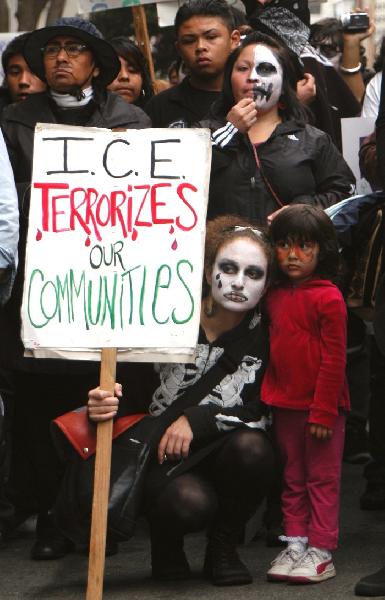by Sharat G. Lin
Saturday, Nov. 08, 2008 at 5:33 PM
San Jose Peace and Justice Center
For many Mexican immigrants, Día de los Muertos is a day to remember not only the dead, but also the disappeared – those who have been seized in sweeping raids by the U.S. Immigration and Customs Enforcement (ICE). On Halloween day, San Francisco youths protested the raids in front of ICE offices.

1.jpgsufjyh.jpg, image/jpeg, 700x1090
Marking Halloween and Día de los Muertos on a Friday morning, October 31, 2008, scores of youths painted eerie black and white skulls on their faces in Ferry Park at San Francisco’s Embarcadero. They dressed in black and painted signs and banners. Then they marched, nearly a thousand strong, to the Northern California headquarters of U.S. Immigration and Customs Enforcement (ICE).
They carried signs saying “No ICE,” “ICE terrorizes communities,” “Keep families together,” “Deportations = state terrorism,” and “If capital can cross borders, so can we.”
One sign read, “No somos uno. No somos cien. Somos un chingo, cuéntanos bien,” (“We are not one. We are not a hundred. We are a lot [of people]”) reflecting a very colloquial usage among Mexican and California Latino youth.
After arriving at ICE headquarters at 630 Sansome Street, two young women who had never met before extemporaneously performed Aztec ceremonies and dance. San Francisco School Board candidate Barbara López came to speak words of support for the crowd.
Meanwhile, other youths sat down in the street behind the United States Appraisers Building, where ICE offices are located, and linked arms through pipes and metal barrels resembling oil drums. In a very precisely-organized act of nonviolent civil disobedience, the youths blocked all traffic to the rear of the building for two hours, including all loading and unloading of cargo.
Organizers called the protest a “youth-led resistance against immigration raids and deportation” and “the violence done to immigrants and families” in Mexico, Central and South America, Africa, Asia, and other areas of emigration.
The specific day was chosen for added symbolism. Celebrated in mainly in Mexico as a day to remember relatives and friends who have passed away, Día de los Muertos (Day of the Dead) follows on the heels of Halloween in the United States and features displays of skulls, skeletons, and offerings in memory of the dead. But for many San Francisco Bay Area youths, the memories are not only of the dead, but of the disappeared –- family members or friends who have been seized in escalating ICE raids across the country, including California.

